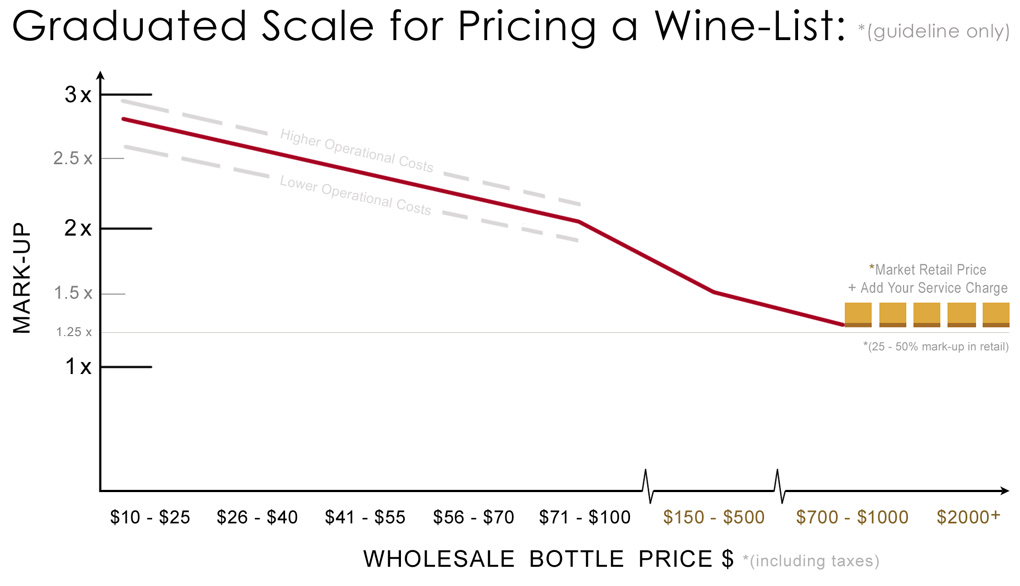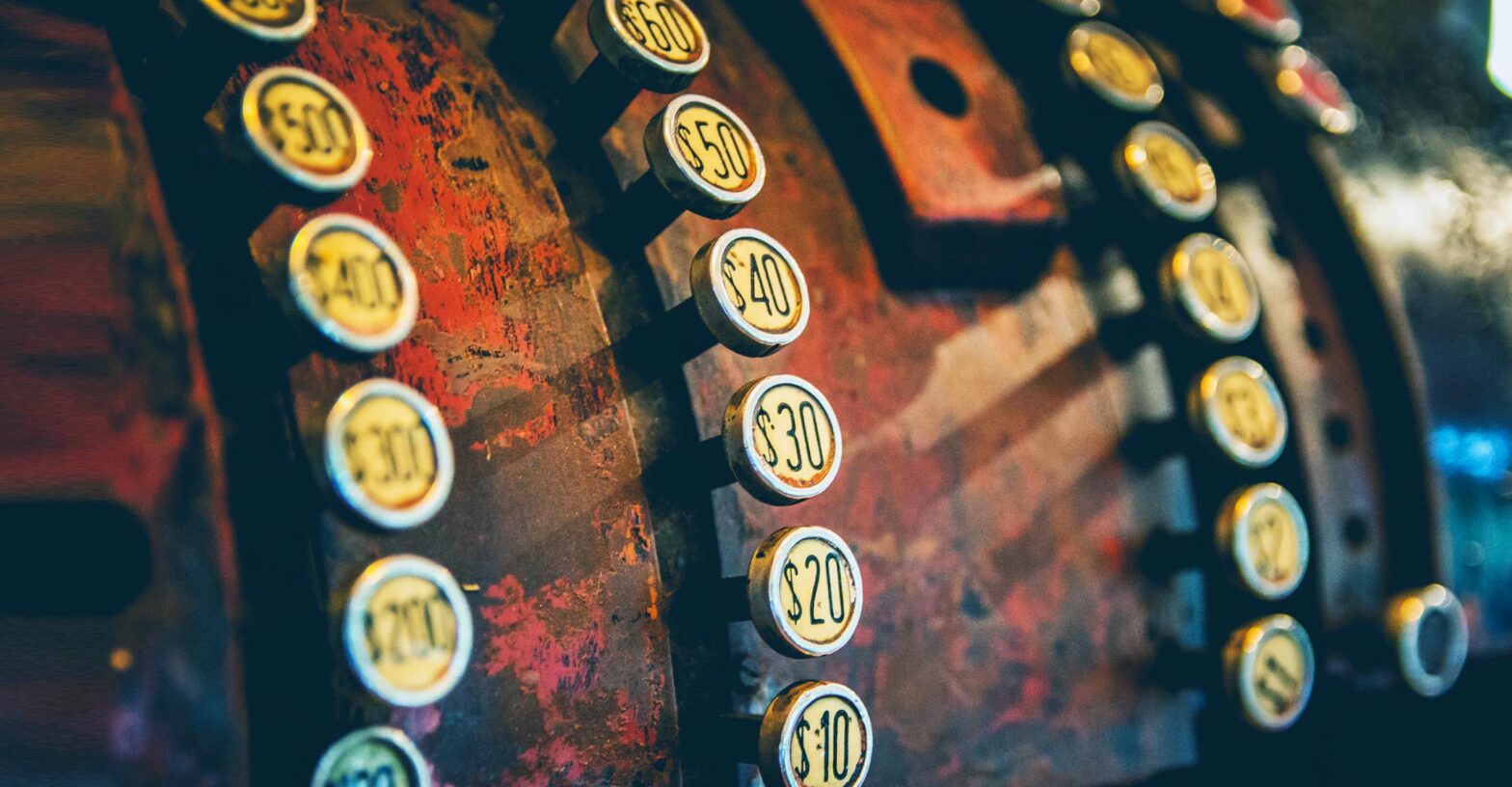Graduated Scale for the Mark-Up on a Wine List:
For more than a decade a growing number - though not all hotels, restaurants and wine bars, use a graduated scale mark-up which goes down as the bottle *(wholesale) price goes up. In general, after a $40 - $50 per bottle profit, restaurants will start to work in an unspoken partnership with the more knowledgeable and adventurous wine enthusiast.
So for example:
• A $25 *(wholesale) bottle of wine maybe sold / listed at $65 - *(2.5 x mark-up).
• But an *$80 bottle of wine might be sold on the wine list for $160 - *(2 x mark-up).
• And a *$150 bottle might be listed for $225 *(1.5 x mark-up) - but with a $75 per bottle profit.
You do not want to price out your guests from premium wines, so having a graduated pricing structure is a good strategy.
Then when you get up to wines that cost more than $500 (wholesale) per bottle, and your establishment is well known for premium, rare wines - and you have clientele looking for and who will appreciate premium, rare and expensive wines. Along with your venue providing the atmosphere, location, experience, stemware, cuisine and level of service. Plus you have already paid for the wine and stored-cellared is carefully, you deserve to be paid for all your efforts. But you still need to be realistic (be fully aware of your economic surroundings and guest demographics) and also make it attractive, so someone will purchase it and enjoy it at its peak with your cuisine... - that is why you bought the wine in the first place.
So the mark-up on highly premium wines can vary dramatically due to the above value - but it is not un-heard of for the listed wine-list price to be simply $100 - $150 on top of the market *retail price. As these wines are sold at a premium in retail - (but hopefully you purchased it at wholesale, so you will have a good margin / profit, but you also made a big call and investment).
But you still want to sell the bottle of wine - so instead of someone not enjoying this wine in your venue - you more than cover your costs - and as you are not generally doing anymore to serve a $1000 bottle of wine to serving a $50 bottle of wine. Except maybe providing Eisch ‘SensisPlus’ stemware and a decanter. So the mark-up can typically be an honest and acceptable ‘service charge’ on top of the market *retail price.
The knowledgeable wine crowd will and do notice this and will frequent these restaurants / wine-bars if they want to enjoy a premium, rare and expensive wines with their dining experience. From a psychological perspective, guests will think it unfair of you to make the same margin or use the same mark-up formula on a premium priced wine as a more affordable wine, when the service and effort going into providing both is the same.
Most well thought-through wine-lists will follow a graduated mark-up, with the highest mark-ups on the lowest priced wines (the more frequent, higher volumes), and a lower mark-up on higher-priced (less frequent, low volume) wines.
For each venue there is a magic tipping-point on a wine-list where a restaurant wine manager will start to lower the bottle mark-up on more premium wines. With the aim to sell more and improve the level enjoyment for their customers. Many of you will have seen this next example: A venue pays $70 for a bottle of wine, and you see it listed for $200 and the venue waits six months or longer for someone to buy it. Or the venue could have listed it at $140 and sell it much quicker, (and possibly more than one) and with a $70 profit per bottle.
• So what are you the customer paying for:
Well to name just a few details, the venue has a number of staff serving you and cooking for you, washing your dishes and the different wine glasses you used etc… and they have to replace the glass you accidently broke. Cover their fixed costs like: rent, council rates & services, gas, electricity, ongoing maintenance of tables, chairs and cleaning of the restaurant, toilets etc. Your favourite establishment is not able to do all of this for free.
• Some ideas on how to get the best value from a well-crafted wine list:
Spend slightly more to achieve better value - as mentioned above most wine-lists will have higher mark-ups on the lower price wines and lower mark-ups on high-end wines, so often the more you spend, the better value of wine on a wine-list.
Unless you know the establishment and the engaged staff are well trained and free flowing with relevant wine recommendations - I would suggest ordering around the middle of each varietal category on a wine-list. In some venues and hotels, the second to least expensive wine on the wine-list is often marked up the most. Why? - (worldwide buying habits for more than 30 years) - most people do not want to look cheap, so they order the second cheapest wine - so my advice is to go one or two steps - listings higher for better value on their wine-list.
Beware of venues exploiting well known, big brand names. As it is still a common practice around the world that popular-big wine brands always seem to get the full or even higher mark-up because they sell no matter what, so beware some venues exploiting well-known wines.
• As much as you can - be adventurous in your wine choices:
A number of wine managers try very hard to place their own personal favourite wine on the list - but many do not think a lot of people will know or order it, so they tend to put a lower mark-up on it. So it is always a good practice to talk with the wine manager or engaged staff and ask for the most interesting new wines on the list, and they will typically forget about paying the bills for a moment and passionately talk about well crafted, drinking now wines - and reveal wines of genuine value to enjoy.
Restaurants & Wine Bars alike, please remember - you cannot get away from price (and the customers perception, plus their budget for the occasion they are having in your venue are key influencers) - virtually all surveys you read across the globe, approximately 75% of customers say price is the most important factor when making a decision on which wine to purchase on a wine-list. So do your research, know your market, also be willing to be flexible and respond to your customers behaviour after a few weeks of introducing a new wine list and menu - as regardless of price and selection, if you do not provide consistently good, genuine service from engaged staff - customers will not come back.

